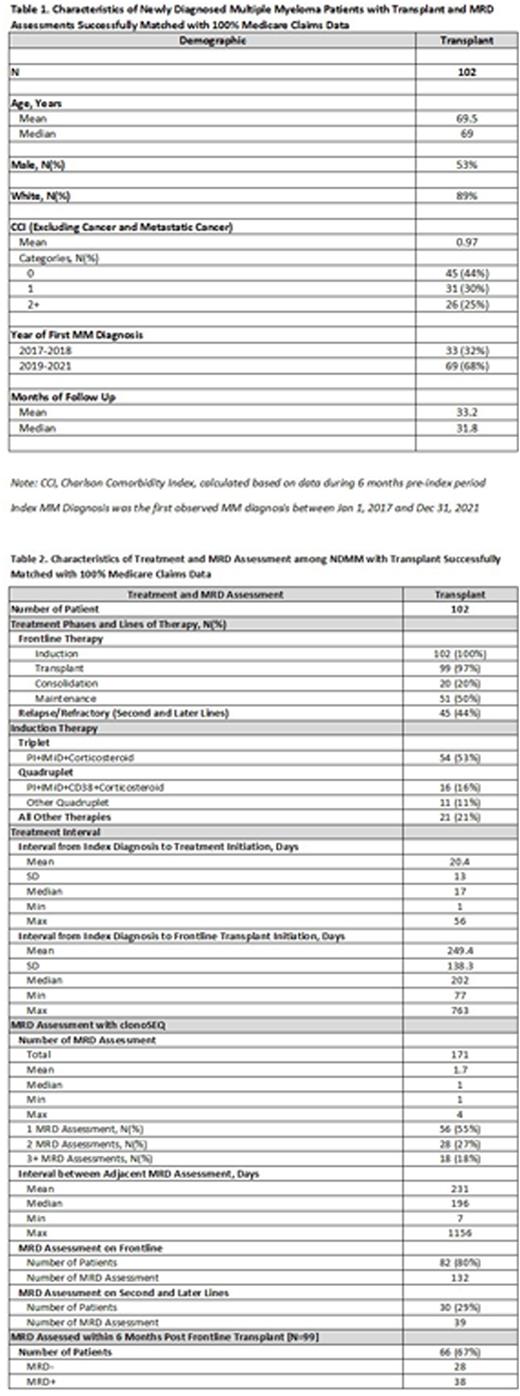Abstract
Introduction
The assessment of minimal residual disease (MRD) for multiple myeloma (MM) has been increasingly incorporated into both clinical trials and patient management. MRD assessment, using an assay with a minimum sensitivity of 10-5 or better, is now recommended within NCCN guidelines following the completion of treatment phases. The clonoSEQ Assay (Adaptive Biotechnologies; Seattle, WA) is currently the only FDA cleared test available for bone-marrow MRD assessment in MM patients, and its use in routine clinical practice across the US facilitates an important new ability to evaluate MRD patterns and outcomes in the real-world setting. This study examined a cohort of Medicare MM patients who underwent transplant, and described characteristics of the treatments and MRD assessment these patients received. Claims-based analyses exploring MM treatments in the real-world have been published (Song 2016, Fonseca 2020), however to our knowledge this is the first study to match distinct claims datasets with corresponding MRD testing patterns and results.
Methods
The study population includes MM patients who had been assessed for MRD with clonoSEQ, who were successfully matched with 100% Medicare claims data. Newly diagnosed MM (NDMM) patients were identified as adult fee-for-service (FFS) beneficiaries with a diagnosis of MM between January 2017 to December 2021 (the first observed MM diagnosis is Index Diagnosis), with continuous coverage in Medicare FFS Parts A/B/D of at least 6 months during pre-index and 12 months during post-index period. Patients were further required to have initiated MM treatment within 60 days of Index Diagnosis, received a transplant, had at least one MRD assessment with clonoSEQ, and had no enrollment in clinical trials nor prior MM treatment pre-index. Phases of treatment within frontline therapy and line of therapy (LOT) were identified following established rules from the literature. Charlson Comorbidity Index (CCI) was calculated during the 6 months pre-index. We describe patient characteristics, treatment journey, and assessment of MRD test results at a sensitivity of 10-5 in accordance with IMWG guidance.
Results
The study identified 102 NDMM transplant patients meeting the above criteria, among which 99 received transplant as part of frontline therapy. The mean age of the cohort was 69 years, 53% were male, and 89% were white. The mean CCI was 0.97. One third of patients were diagnosed between 2017-2018. Both the mean and median follow-up time for this cohort are 32 months.
Among the 102 patients, approximately 20% received consolidation and 50% received maintenance, as part of their frontline regimen; 44% received second or later LOT. The most common induction therapies used in this cohort were a PI+IMiD+Corticosteroid triplet (53%) or a PI+IMiD+CD38+Corticosteroid quadruplet (16%). On average, transplant patients started treatment 20 days from Index Diagnosis and received transplant 249 days from Index Diagnosis.
A total of 171 MRD assessment were performed among this population with an average of 1.7 assessments and a maximum of 4 assessments per patient. Approximately 45% of transplant patients had >=2 MRD assessments and the median interval between adjacent MRD assessment is 196 days. Most of the patients (80%) were being assessed for MRD during frontline therapy, while 29% also received MRD assessment during later lines.
Of the 99 patients who received transplant during frontline therapy, 66 (67%) patients had an MRD assessment within 6 months of transplant. Among them, 28 (42%) were MRD negative.
Conclusions
This is the first study to map treatment phases and line of therapy with Medicare claims data and examine the characteristics of MRD assessment in NDMM transplant patients. The study provides insight into real-world MRD testing patterns and outcomes within the Medicare population using next-generation sequencing. Further applications of this methodology to evaluate therapeutic response and understand MRD-supported decision making in the real-world setting are planned.
Disclosures
Jiang:AstraZeneca LLC: Ended employment in the past 24 months; Adaptive Biotechnologies: Current Employment, Current equity holder in publicly-traded company. Kardel:Alexion: Consultancy; Adaptimmune: Consultancy; AgNovos: Consultancy; Adaptive Biotechnologies: Consultancy; Avanos: Consultancy; Beigene: Consultancy; Biogen: Consultancy; Bristol Myers Squibb: Consultancy; GRAIL: Consultancy; GlaxoSmithKline: Consultancy; Lilly: Consultancy; Medtronic: Consultancy; Mirvie: Consultancy; Myriad: Consultancy; PhRMA (Pharmaceutical Research and Manufacturers of America): Consultancy; Takeda: Consultancy; Urogen: Consultancy. Varghese:Alexion: Consultancy; Adaptimmune: Consultancy; AgNovos: Consultancy; Adaptive Biotechnologies: Consultancy; Beigene: Consultancy; Bristol Myers Squibb: Consultancy; GRAIL: Consultancy; GlaxoSmithKline: Consultancy; Lilly: Consultancy; Medtronic: Consultancy; Mirvie: Consultancy; Myriad: Consultancy; PhRMA (Pharmaceutical Research and Manufacturers of America): Consultancy; Takeda: Consultancy; Urogen: Consultancy; Avanos: Consultancy; Biogen: Consultancy. Hewitt:Adaptive Biotechnologies: Current Employment, Current equity holder in publicly-traded company, Divested equity in a private or publicly-traded company in the past 24 months. Simmons:Adaptive Biotechnologies: Current Employment, Current equity holder in publicly-traded company. Eckert:Adaptive Biotechnologies: Current Employment, Current equity holder in publicly-traded company, Divested equity in a private or publicly-traded company in the past 24 months.
Author notes
Asterisk with author names denotes non-ASH members.


This feature is available to Subscribers Only
Sign In or Create an Account Close Modal